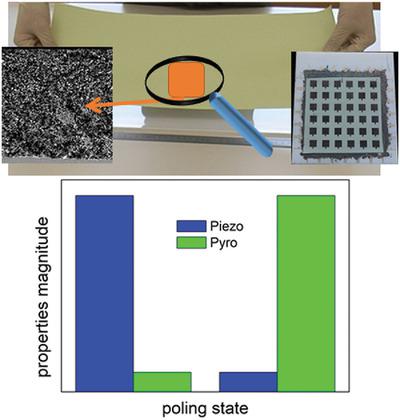当前位置:
X-MOL 学术
›
Macromol. Mater. Eng.
›
论文详情
Our official English website, www.x-mol.net, welcomes your feedback! (Note: you will need to create a separate account there.)
Large Area Thick Films of PVDF‐TrFE and Relaxor‐Ceramics for Piezo‐ and Pyroelectric Applications
Macromolecular Materials and Engineering ( IF 3.9 ) Pub Date : 2019-10-15 , DOI: 10.1002/mame.201900538 Matthias Dietze 1 , Mohammed Es‐Souni 1
Macromolecular Materials and Engineering ( IF 3.9 ) Pub Date : 2019-10-15 , DOI: 10.1002/mame.201900538 Matthias Dietze 1 , Mohammed Es‐Souni 1
Affiliation

|
Wearable electronics, sensors, and energy harvesting devices are gaining an ever increasing importance in consumer products. Their success is, however, contingent on the availability of flexible and cost‐effective functional materials. The present paper presents an up‐scaled processing route for 0–3 thick film composites of the ferroelectric polymer polyvinylidenefluoride‐trifluoroethylene and a relaxor ceramic. Different compositions are investigated for pyro‐ and piezoelectric applications. Various samples are produced via tape casting and spin‐coating as freestanding and supported films of up to 600 × 200 mm² and on 150 mm silicon wafers, respectively. The samples are characterized in terms of thickness and roughness reproducibility, mechanical properties, and impedance. It is shown that good reproducibility and quality of the films can be realized. Depending on the application targeted (pyroelectric or piezoelectric), specific compositions together with the suitable poling process are presented. For instance, a composite with 24 vol% ceramic shows highest pyroelectric properties together with lowest piezoelectric thickness coefficient (d33) when poled for pyroelectric applications. On the other hand, a composite with 50 vol% ceramic exhibits a d33 of 100 pm V−1 that is unsurpassed for this type of composites. These properties are advantageous in a large variety of applications, including wearable devices.
中文翻译:

压电和热电应用的PVDF-TrFE和弛张陶瓷大面积厚膜
可穿戴电子设备,传感器和能量收集设备在消费产品中的重要性日益提高。但是,它们的成功取决于是否提供了灵活且具有成本效益的功能材料。本文介绍了铁电聚合物聚偏二氟乙烯-三氟乙烯与弛豫陶瓷的0–3厚膜复合材料的放大工艺路线。针对热解和压电应用研究了不同的成分。通过流延和旋涂生产各种样品,分别是独立的和支撑的膜,最大可达600×200mm²,并在150 mm的硅晶片上。根据厚度和粗糙度的再现性,机械性能和阻抗对样品进行表征。结果表明,可以实现薄膜的良好再现性和质量。根据目标应用(热电或压电),提出了特定的成分以及合适的极化方法。例如,陶瓷含量为24%(体积)的复合材料显示出最高的热电性能以及最低的压电厚度系数(d 33)为热电应用极化时。另一方面,陶瓷含量为50%(体积)的复合材料的d 33为100 pm V -1,是这类复合材料无法超越的。这些特性在包括可穿戴设备在内的各种应用中都是有利的。
更新日期:2019-12-05
中文翻译:

压电和热电应用的PVDF-TrFE和弛张陶瓷大面积厚膜
可穿戴电子设备,传感器和能量收集设备在消费产品中的重要性日益提高。但是,它们的成功取决于是否提供了灵活且具有成本效益的功能材料。本文介绍了铁电聚合物聚偏二氟乙烯-三氟乙烯与弛豫陶瓷的0–3厚膜复合材料的放大工艺路线。针对热解和压电应用研究了不同的成分。通过流延和旋涂生产各种样品,分别是独立的和支撑的膜,最大可达600×200mm²,并在150 mm的硅晶片上。根据厚度和粗糙度的再现性,机械性能和阻抗对样品进行表征。结果表明,可以实现薄膜的良好再现性和质量。根据目标应用(热电或压电),提出了特定的成分以及合适的极化方法。例如,陶瓷含量为24%(体积)的复合材料显示出最高的热电性能以及最低的压电厚度系数(d 33)为热电应用极化时。另一方面,陶瓷含量为50%(体积)的复合材料的d 33为100 pm V -1,是这类复合材料无法超越的。这些特性在包括可穿戴设备在内的各种应用中都是有利的。


























 京公网安备 11010802027423号
京公网安备 11010802027423号